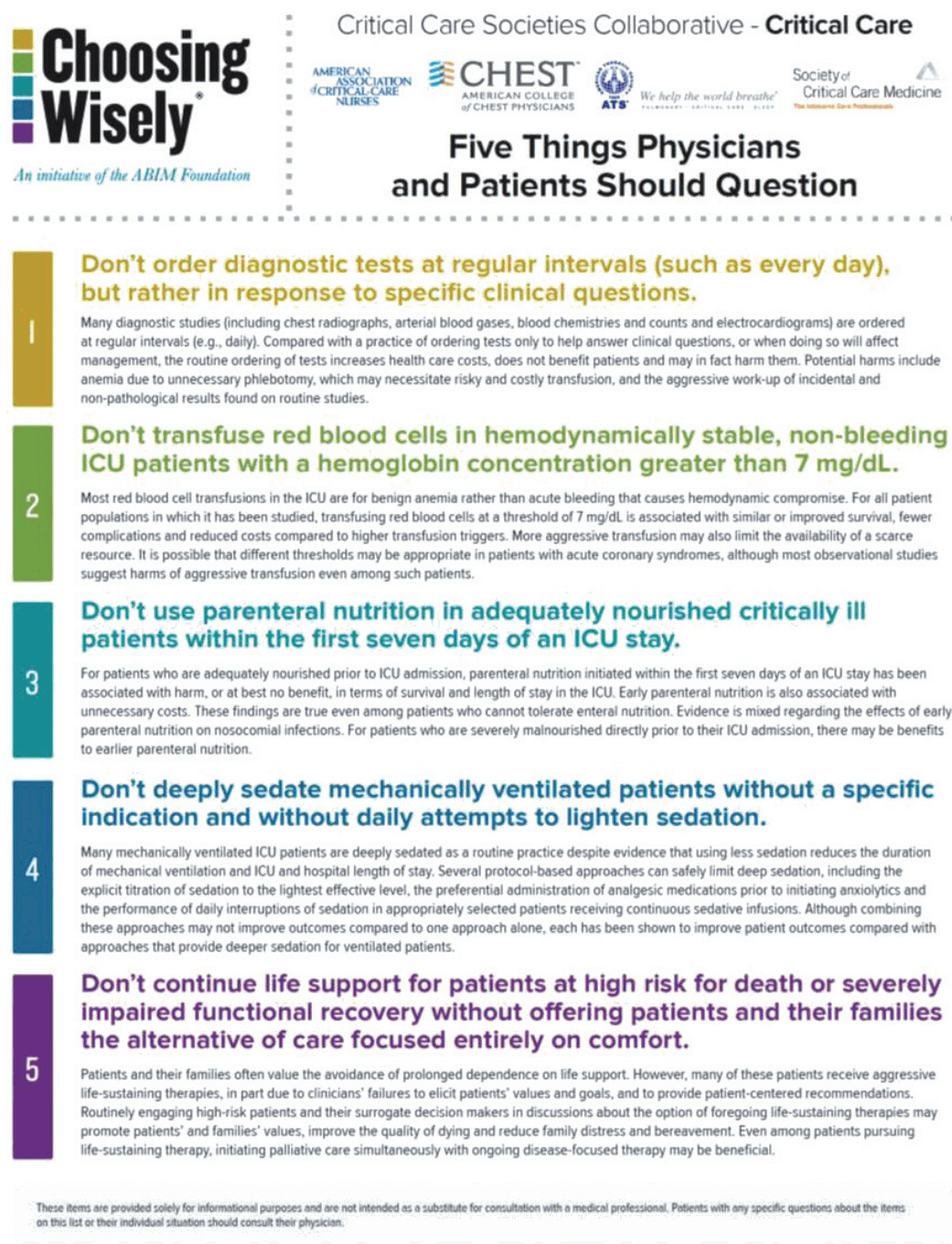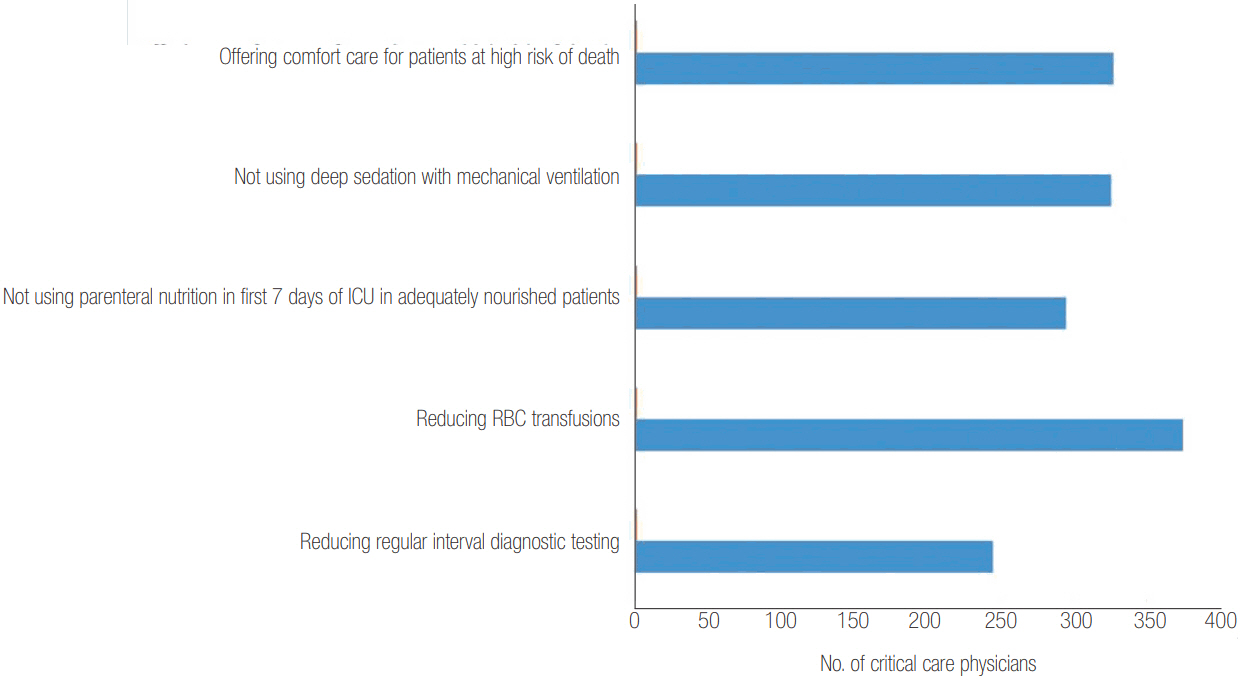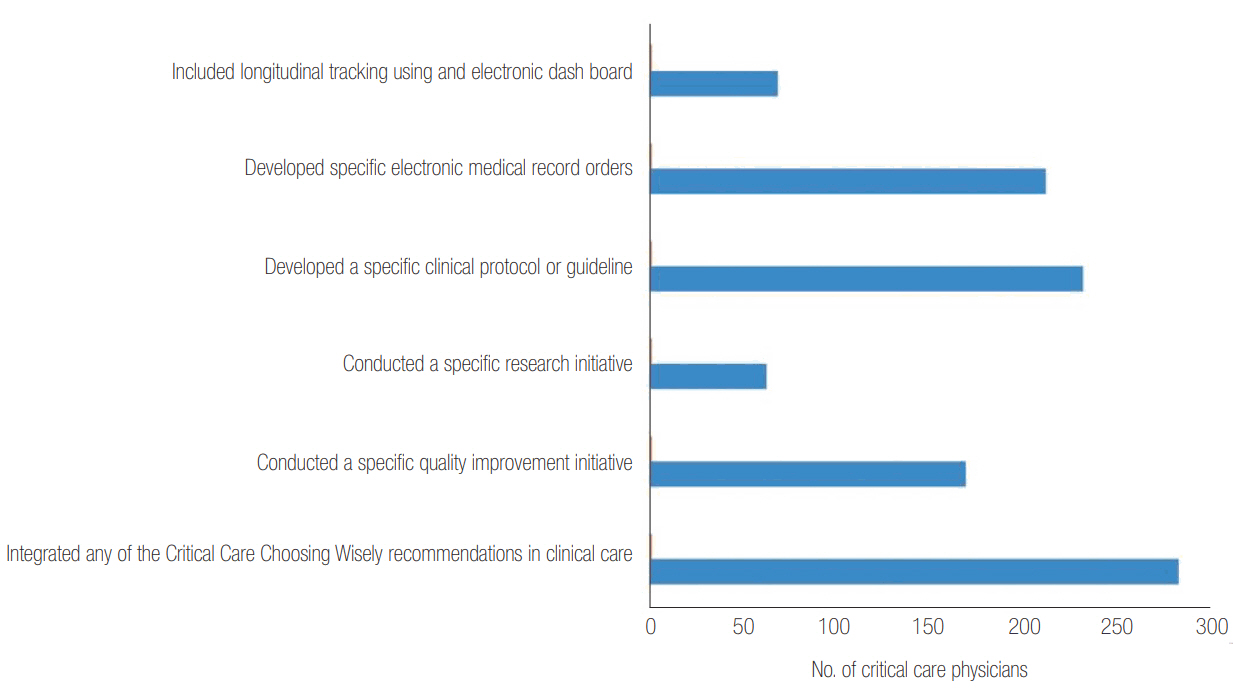Acute Crit Care.
2018 Feb;33(1):1-6. 10.4266/acc.2018.00052.
Reducing Unnecessary Testing in the Intensive Care Unit by Choosing Wisely
- Affiliations
-
- 1Vanderbilt University Medical Center and School of Nursing, Nashville, TN, USA. ruth.kleinpell@vanderbilt.edu
- 2Rush University Medical Center and College of Nursing, Chicago, IL, USA.
- 3Mayo Clinic, Phoenix, AZ, USA.
- 4Critical Care Center, Department of Anesthesiology and Critical Care Medicine, Memorial Sloan Kettering Cancer Center, New York, NY, USA.
- KMID: 2436301
- DOI: http://doi.org/10.4266/acc.2018.00052
Abstract
- Overuse of laboratory and X-ray testing is common in the intensive care unit (ICU). This review highlights focused strategies for critical care clinicians as outlined by the Critical Care Societies Collaborative (CCSC) as part of the American Board of Internal Medicine Foundation's Choosing Wisely® campaign. The campaign aims to promote the use of judicious testing and decrease unnecessary treatment measures in the ICU. The CCSC outlines five specific recommendations for reducing unnecessary testing in the ICU. First, reduce the use of daily or regular interval diagnostic testing. Second, do not transfuse red blood cells in hemodynamically stable, non-bleeding ICU patients with a hemoglobin concentration greater than 7 mg/dl. Third, do not use parenteral nutrition in adequately nourished critically ill patients within the first 7 days of ICU stay. Fourth, do not deeply sedate mechanically ventilated patients without a specific indication and without daily attempts to lighten sedation. Finally, do not continue life support for patients at high risk of death without offering patients and their families the alternative of comfort focused care. A number of strategies can be used to reduce unnecessary testing in the ICU, including educational campaigns, audit and feedback, and implementing prompts in the electronic ordering system to allow only acceptable indications when ordering routine testing. Greater awareness of the lack of outcome benefit and associated costs can prompt clinicians to be more mindful of ordering tests and procedures in order to reduce unnecessary testing in the ICU.
MeSH Terms
Figure
Reference
-
1. Peixoto AA Jr, Meneses FA, Barbosa BP, Pessoa LF, Melo RH, Fideles GM. Laboratory routine in the ICU: a practice to be abolished? Crit Care. 2013; 17(Suppl 3):P12.
Article2. Choosing Wisely [Internet]. Philadelphia (PA): ABIM Foundation;2018. [cited 2018 Jan 10]. Available from: www.choosingwisely.org.3. Cassel CK, Guest JA. Choosing wisely: helping physicians and patients make smart decisions about their care. JAMA. 2012; 307:1801–2.4. Choosing Wisely Canada [Internet]. Toronto (ON): University of Toronto, Canadian Medical Association, St. Michael’s Hospital;2018. [cited 2018 Jan 10]. Available from: http://www.choosingwiselycanada.org.5. Consumer Reports [Internet]. Yonkers (NY): Consumer Reports;2018. [cited 2018 Jan 20]. Available from: http://www.consumerreports.org/cro/health/doctors-and-hospitals/choosing-wisely/index.htm.6. Critical Care Societies Collaborative. Choosing Wisely list for critical care: five things physicians and patients should question [Internet]. Philadelphia (PA): ABIM Foundation;[cited 2018 Jan 10]. Available from: http://ccsconline.org/images/CCSC-Choosing-Wisely.pdf.7. Iams W, Heck J, Kapp M, Leverenz D, Vella M, Szentirmai E, et al. A multidisciplinary housestaff-led initiative to safely reduce daily laboratory testing. Acad Med. 2016; 91:813–20.
Article8. Bulger J, Nickel W, Messler J, Goldstein J, O’Callaghan J, Auron M, et al. Choosing wisely in adult hospital medicine: five opportunities for improved healthcare value. J Hosp Med. 2013; 8:486–92.
Article9. Ivers N, Jamtvedt G, Flottorp S, Young JM, Odgaard-Jensen J, French SD, et al. Audit and feedback: effects on professional practice and healthcare outcomes. Cochrane Database Syst Rev. 2012; (6):CD000259.
Article10. Canadian Agency for Drugs and Technologies in Health. Rapid response report. Routine blood tests for patients in the intensive care unit: clinical effectiveness, cost-effectiveness, and guidelines. Ottawa (ON): Canada;2013.11. Society of Critical Care Medicine. National survey of ICU clinicians assessing knowledge and use of the Choosing Wisely campaign. Mount Prospect (IL): Society of Critical Care Medicine;2017.12. Colla CH, Mainor AJ, Hargreaves C, Sequist T, Morden N. Interventions aimed at reducing use of low-value health services: a systematic review. Med Care Res Rev. 2017; 74:507–50.
Article13. Colla CH, Morden NE, Sequist TD, Schpero WL, Rosenthal MB. Choosing Wisely: prevalence and correlates of low-value health care services in the United States. J Gen Intern Med. 2015; 30:221–8.
Article14. Goddard K, Austin SJ. Appropriate regulation of routine laboratory testing can reduce the costs associated with patient stay in intensive care. Crit Care. 2011; 15(Suppl 1):P133.
Article15. Iosfina I, Merkeley H, Cessford T, Geller G, Amiri N, Baradaran N, et al. Implementation of an on-demand strategy for routine blood testing in ICU patients. Am J Respir Crit Care Med. 2013; 187:A5322.16. Pageler NM, Franzon D, Longhurst CA, Wood M, Shin AY, Adams ES, et al. Embedding time-limited laboratory orders within computerized provider order entry reduces laboratory utilization. Pediatr Crit Care Med. 2013; 14:413–9.
Article17. Pines JM, Newman D, Pilgrim R, Schuur JD. Strategies for integrating cost-consciousness into acute care should focus on rewarding high-value care. Health Aff (Millwood). 2013; 32:2157–65.
Article18. Porter ME. What is value in health care? N Engl J Med. 2010; 363:2477–81.
Article
- Full Text Links
- Actions
-
Cited
- CITED
-
- Close
- Share
- Similar articles
-
- Choosing Wisely Campaign for Appropriate Health Care
- Risk Factors for Cognitive Impairment in Intensive Care Unit Survivors
- Rehabilitation in Intensive Care Unit
- Can the intensivists predict the outcomes of critically ill patients on the appropriateness of intensive care unit admission for limited intensive care unit resources ?
- Organisation of Special and Intensive Care Facilities for Babies




